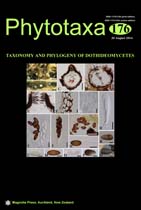Abstract
Kalmusia ebuli, the type species of Kalmusia, lacks type material and therefore its phylogenetic position remains unresolved. As a consequence the familial position of Kalmusia is based on morphology and molecular phylogeny of species other than the type. A fresh collection of K. ebuli, recently obtained from decorticated wood of Populus tremula in the foothills of the French Pyrenees is, therefore, designated as neotype to stabilize the application of the species and/or genus name. The holotype of K. ebuli f. sarothamni represents a synonym of K. ebuli. The genus Kalmusia is shown to be polyphyletic within the family Montagnulaceae, with K. ebuli being distant from K. brevispora and K. scabrispora, which appear to represent a different genus.

